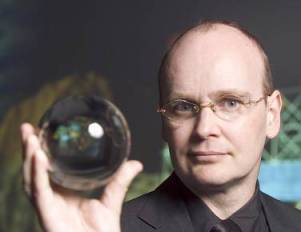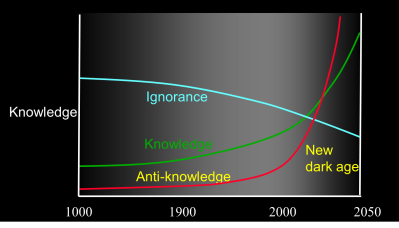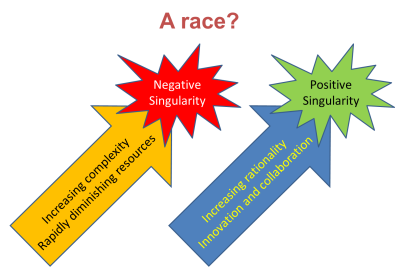I’ll welcome some feedback. The looming advent of the UK General Election in May this year has focused some minds – minds that are unhappy that too much of the political debate ignores some very important topics. These are the topics of the likelihood of large societal changes occurring in the next 5-10 years – changes arising from breakthroughs in multiple fields of technology. Politicians, for various reasons, aren’t giving much mind-share to these impending changes.
The outcome of this unhappiness about the current political discussion is the idea of launching a “transhumanist political manifesto”. The current draft of this document is below. (It’s a live document, and may have changed by the time you read this blogpost. You can access the live draft here.)
All being well, a later version of this document will be used as part of a checklist, in the next few months, to publicly evaluate various political parties for their degree of “future-readiness”.
The feedback I’m interested in is this. Especially if you consider yourself a transhumanist (or have some sympathies for that philosophy), what’s your reaction to the points picked out in this draft manifesto? Would you change the content? Or the prioritisation? And to what extent might the content be applicable in other countries, rather than just in the UK?
Preamble: Anticipating tomorrow’s humanity
 Prepared by UK Humanity+ (UKH+)
Prepared by UK Humanity+ (UKH+)
Transhumanism is the viewpoint that human society should embrace, wisely, thoughtfully, and compassionately, the radical transformational potential of technology.
The speed and direction of technological adoption can be strongly influenced by social and psychological factors, by legislation, by subsidies, and by the provision or restriction of public funding. Political action can impact all these factors, either for better or for worse.
UKH+ wishes to engage with politicians of all parties to increase the likelihood of an attractive, equitable, sustainable, progressive future. The policies we recommend are designed:
- To elevate the thinking of politicians and other leaders, away from being dominated by the raucous issues of the present, to addressing the larger possibilities of the near future
- To draw attention to technological opportunities, map out attractive roads ahead, and address the obstacles which are preventing us from fulfilling our cosmic potential.
Headlines
UKH+ calls upon politicians of all parties to define and support:
- Regenerative projects to take full advantage of accelerating technology.
More specifically, we call for:
- Economic and personal liberation via the longevity dividend
- An inclusive new social contract in the light of technological disruption
- A proactionary regulatory system to fast-track innovative breakthroughs
- Reform of democratic processes with new digital tools
- Education transformed in readiness for a radically different future
- A progressive transhumanist rights agenda
- An affirmative new perspective on existential risks.
Details
1. Regenerative projects to take full advantage of accelerating technology
Anticipating profound change
Accelerating technological progress has the potential to transform lives in the next ten years more profoundly than in any preceding ten year period in history.
Radical technological changes are coming sooner than people think, in technology fields such as nanotechnology, synthetic biology, renewable energy, regenerative medicine, brain sciences, big data analytics, robotics, and artificial intelligence. Together, these technologies will change society in unexpected ways, disrupting familiar patterns of industry, lifestyle, and thinking.
These changes include the potential for exceptional benefits for both the individual and society, as well as the potential for tremendous risk.
Current policymakers rarely tackle the angle of convergent disruptive technologies. This means they react to each new disruption with surprise, after it appears, rather than anticipating it with informed policy and strategy.
Politicians of all parties urgently need to:
- Think through the consequences of these changes in advance
- Take part in a wide public discussion and exploration of these forthcoming changes
- Adjust public policy in order to favour positive outcomes
- Support bold regenerative projects to take full advantage of accelerating technology – projects with the uplifting vision and scale of the 1960s Apollo moonshot program.
These bold regenerative projects can galvanize huge collaborative endeavours, via providing a new sense of profound purpose and shared destiny.
Benefits from profound change
The outcomes of these regenerative projects can:
- Enable humans to transcend (overcome) many of the deeply debilitating, oppressive, and hazardous aspects of our lives
- Allow everyone a much wider range of personal autonomy, choice, experience, and fulfilment
- Facilitate dramatically improved international relations, social harmony, and a sustainable new cooperation with nature and the environment.
Managing the regenerative projects
These projects can be funded and resourced:
- By tapping into a well-spring of positive motivation and discretionary effort which these projects will unleash
- By benefiting from the longevity dividend, in which less budget will be consumed by end-of-life healthcare
- From smarter forms of international cooperation, which should reduce costs from efforts duplicated between different countries
- By progressively diverting funding from military budgets to regenerative budgets
- By eliminating the loopholes which allow multinational companies to shuffle revenues between countries and thereby avoid paying due taxes
- From savings from applying principles of automation and Information Technology wherever applicable.
The policies in this manifesto are designed to expedite these positive transformations whilst avoiding adverse consequences.
2. Economic and personal liberation via the longevity dividend
Given adequate resources, human longevity could be enormously extended using technologies which are already broadly understood. Prolonging healthy lifespan would clearly benefit the very large number of citizens concerned, and it would also benefit society by preserving and deepening the experience and wisdom available to solve our various social problems.
Transhumanists aspire to indefinite healthy life extension. Rejuvenation therapies based on regenerative medicine can and should be developed and progressively made available to all citizens. The resulting “longevity dividend” will have large social and economic benefits, as well as personal ones. We do not believe it would impose a dangerous pressure on resources. We call for a bold new moonshot-scale project with the specific goal of ameliorating the degenerative aging process and significantly extending healthy human lifespan.
A practical suggestion is that 20% of the public research funding that currently goes to specific diseases should be reassigned, instead, to researching solutions to aging. In line with the analysis of e.g. SENS, the “ending aging” angle is likely to provide promising lines of research and solutions to many diseases, such as senile dementia (including Alzheimer’s), cancer, heart disease, motor neurone disease, respiratory diseases, and stroke.
3. An inclusive new social contract in the light of technological disruption
Emerging technologies – in particular automation – are likely to impose significant strains on the current economic model. It is far from clear how this will play out, nor what are the best strategies for response. Society and its leaders need to consider and discuss these changes, and draw up plans to deal with different outcome scenarios.
Transhumanists anticipate that accelerating technological unemployment may cause growing social disruption and increased social inequality and alienation. A new social contract is needed, involving appropriate social, educational, and economic support for those who are left with no viable option of ‘earning a living’ due to unprecedented technological change.
A form of “negative income tax” (as proposed by Milton Friedman) or a “basic income guarantee” could provide the basis for this new social contract. Some observers feel it may take an moonshot-scale program to fully design and implement these changes in our social welfare systems. However, political parties around the world have developed promising models, backed up by significant research, for how universal basic income might be implemented in a cost-effective manner. UKH+ urges action based on the best of these insights.
A practical suggestion is to repeat the 1970s Canadian “Minincome” guaranteed income experiment in several different locations, over longer periods than the initial experiments, and to monitor the outcome. Further references can be found here andhere.
4. A proactionary regulatory system to fast-track innovative breakthroughs
The so-called “precautionary principle” preferred by some risk-averse policy makers is often self-defeating: seeking to avoid all risks can itself pose many risks. The precautionary principle frequently hinders intelligent innovation. The “proactionary principle” is a better stance, in which risks are assessed and managed in a balanced way, rather than always avoided. Any bias in favour of the status quo should be challenged, with an eye on better futures that can be created.
Transhumanists observe that many potentially revolutionary therapies are under research, but current drug development has become increasingly slow and expensive (as summarised by “Eroom’s law”). Translational research is doing badly, in part due to current drug regulations which are increasingly out of step with public opinion, actual usage, and technology.
In practical terms, UKH+ recommends:
- Streamlining regulatory approval for new medicines, in line with recommendations by e.g. CASMI in the UK
- Removing any arbitrary legal distinction between “therapies for ill-health” and “therapies for enhancement”.
We also urge revisions in patent and copyright laws to discourage counter-productive hoarding of intellectual property:
- Reduce the time periods of validity of patents in certain industry areas
- Make it much less likely that companies can be granted “obvious” patents that give them a throat-choke on subsequent development in an industry area
- Explore the feasibility of alternative and complementary schemes for facilitating open innovation, such as reputation economies or prize funds.
5. Reform of democratic processes with new digital tools
The underpinnings of a prosperous, democratic, open society include digital rights, trusted, safe identities, and the ability to communicate freely without fear of recrimination or persecution. Transhumanists wish to:
- Accelerate the development and deployment of tools ensuring personal privacy and improved cyber-security
- Extend governmental open data initiatives
- Champion the adoption of “Democracy 2.0” online digital tools to improve knowledge-sharing, fact-checking, and collective decision-making
- Increase the usefulness and effectiveness of online petitions
- Restrict the undue influence which finance can have over the electoral and legislative process.
Government policy should be based on evidence rather than ideology:
- Insights from the emerging field of cognitive biases should be adapted into decision-making processes
- New committees and organisations should be designed according to debiasing knowledge, so they are less likely to suffer groupthink
- AI systems should be increasingly used to support smart decision making.
All laws restricting free-speech based on the concept of “personal offence” should be revoked. Anyone accepted into a country, whether as a visitor or as an immigrant, must confirm that they fully accept the principle of free speech, and renounce any use of legal or extralegal means to silence those who offend their religion or worldview.
6. Education transformed in readiness for a radically different future
A greater proportion of time spent in education and training (whether formal or informal) should be future-focused, exploring
- Which future scenarios are technically feasible, and which are fantasies
- Which future scenarios are desirable, once their “future shock” has been accepted
- What actions can be taken to accelerate the desirable outcomes, and avoid the undesirable ones
- How to achieve an interdisciplinary understanding of future scenarios
- How resilience can be promoted, rather than society just having a focus on efficiency
- How creativity can be promoted, rather than society just having a focus on consumption
- The intelligent management of risk.
Lifelong training and education should become the norm, with people of all ages learning new skills as the need becomes apparent in the new age of automation. Educational curricula need to be able to adapt rapidly.
We would mandate that each university and educational establishment makes an increasing proportion of its material freely accessible online every year.
Education should take greater advantage of MOOCs, and the possibility for people having their knowledge certified without enrolling in a traditional college. MOOCs can be usefully complemented with location based learning labs (“makerspaces”) absorbing some of existing library empty space, preserving the “open knowledge” of libraries and expanding it into “open education and learning”. UKH+ anticipates a time where, apart from lab work, the whole of tertiary education will be delivered online.
7. A progressive transhumanist rights agenda
Transhumanists wish to:
- Explore the gradual applicability of selected human rights to sentient beings, such as primates, that demonstrate relevant mental life, and also advanced AIs, that need such rights to function in their respective purpose
- Hasten the adoption of synthetic (in-vitro) meat, and the abolition of cruelty to farm animals.
Transhumanists champion the concept of morphological freedom:
- The rights of all people, including sexual and gender minorities, to bodily self-determination
- Free access to modern reproductive technologies, including genetic screening to improve the quality of life, for all prospective parents
- Making it easier for people, if they so choose, to enter a state of cryonic suspension as their bodies come close to clinical death.
Transhumanists envision support for a radical future for consciousness:
- Enhanced mental cooperation as minds become more interconnected via brain-to-computer interfaces and other foreseeable brain/mind technologies, which will enable the ability to share qualia at rapid speeds.
8. An affirmative new perspective on existential risks
Some emerging technologies – in particular artificial general intelligence and nanotechnology – are so powerful as to produce changes more dramatic than anything since the agricultural revolution. The outcomes could be extraordinarily positive for humanity, or they could threaten our very existence.
Existing technologies already pose potential catastrophic risks to the well-being of humanity:
- The risk persists of accidental nuclear warfare
- Runaway climate change might be triggered by unchecked emissions of greenhouse gases that push global temperatures beyond sudden tipping points.
There are further complications from relatively easy access by alienated, destructive individuals to weapons of mass destruction, including dirty bombs and synthetic pathogens.
Without being complacent, transhumanists believe that sustained human innovation can mitigate all these risks, once they are fully understood. We call for significant resources to be applied to working out how to ensure that the outcomes are positive.
The wise management of the full set of existential risks is likely to involve innovations in technology (e.g. the development and production of cleaner energy sources), economics (e.g. a carbon tax to redress the market failure of unpenalized negative externalities), and politics (e.g. the collaborative creation and enforcement of binding treaties). The end outcome will be the successful harnessing of technologies, both old and new, for the radical enhancement of humanity.
 Abundance
Abundance To channel the energies of industry, business, finance, universities, and the media, for a richly positive outcome within the next generation, swift action is needed:
To channel the energies of industry, business, finance, universities, and the media, for a richly positive outcome within the next generation, swift action is needed: Within one generation – 25 years, that is, by 2040 – human society can and should be radically transformed.
Within one generation – 25 years, that is, by 2040 – human society can and should be radically transformed. As education spreads about the potential for a transhumanist future of abundance, access, and action – and as tangible transhumanist projects are seen to be having an increasingly positive political impact – more and more people will start to identify themselves as transhumanists.
As education spreads about the potential for a transhumanist future of abundance, access, and action – and as tangible transhumanist projects are seen to be having an increasingly positive political impact – more and more people will start to identify themselves as transhumanists.






























